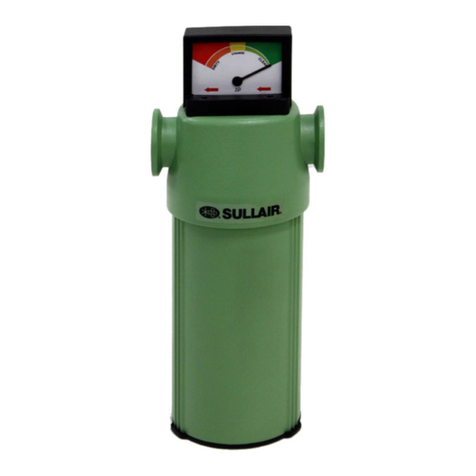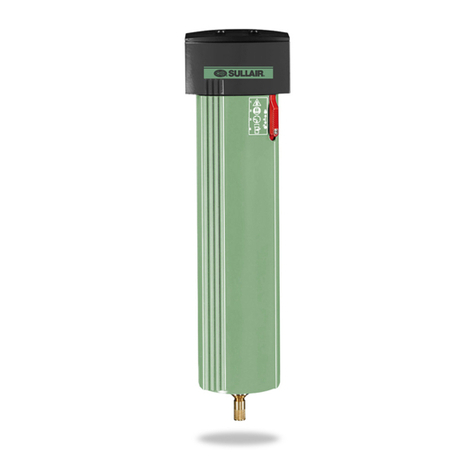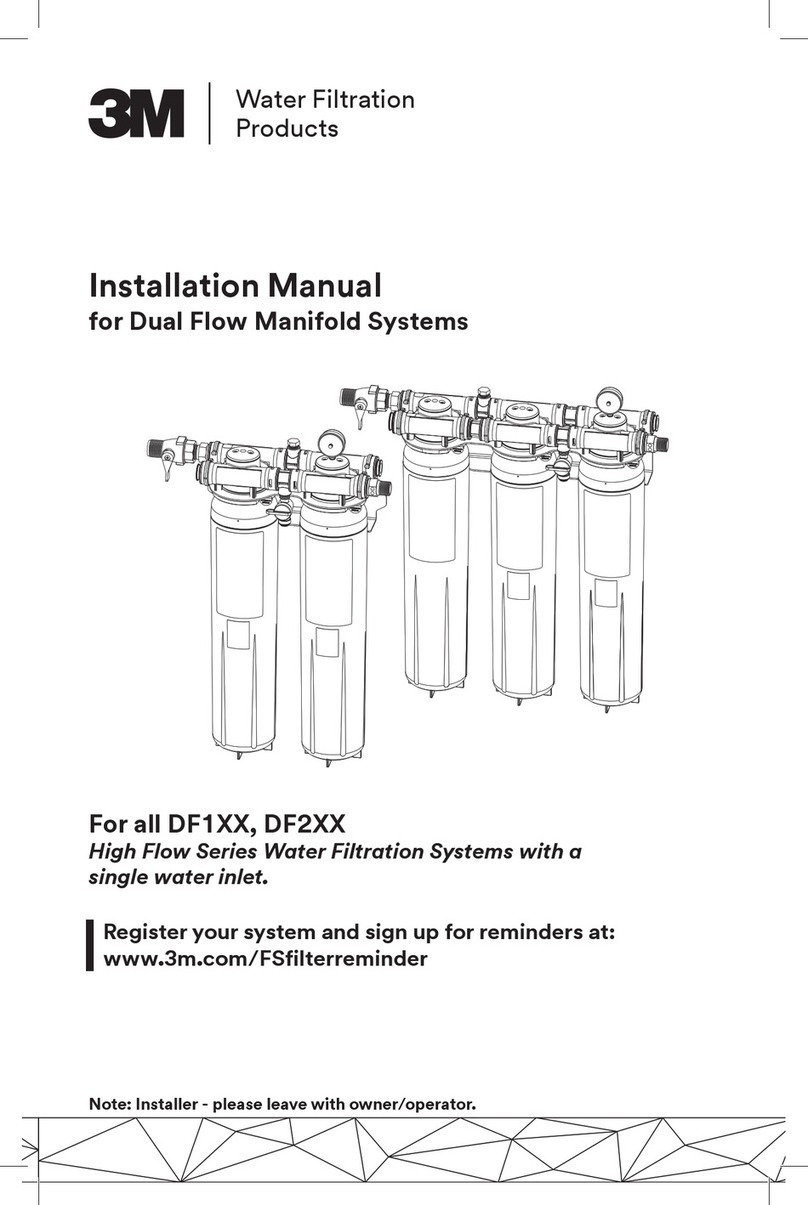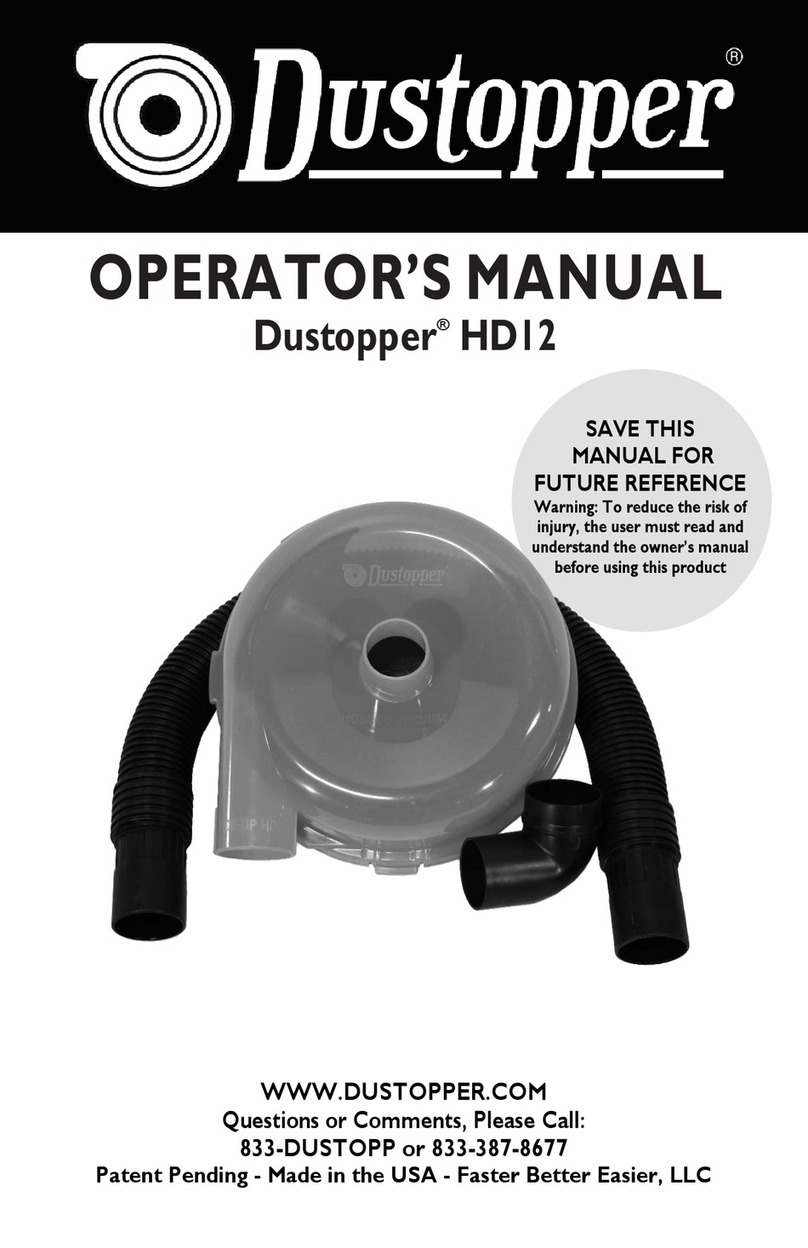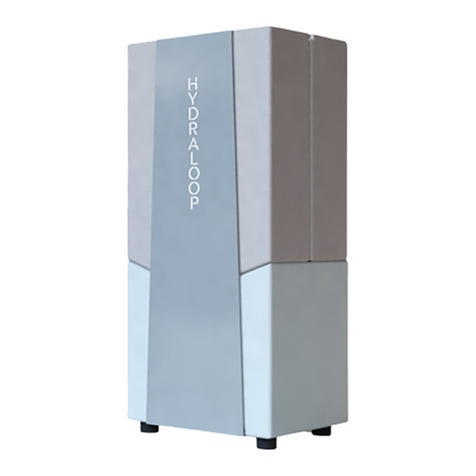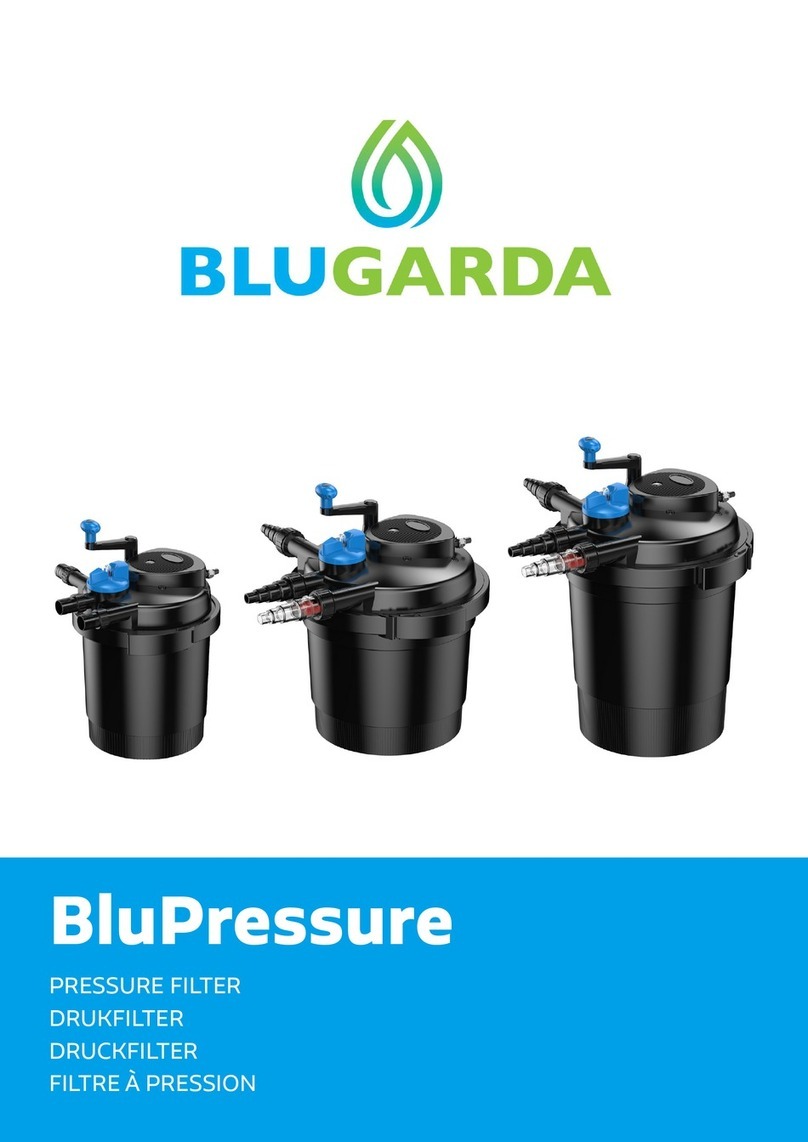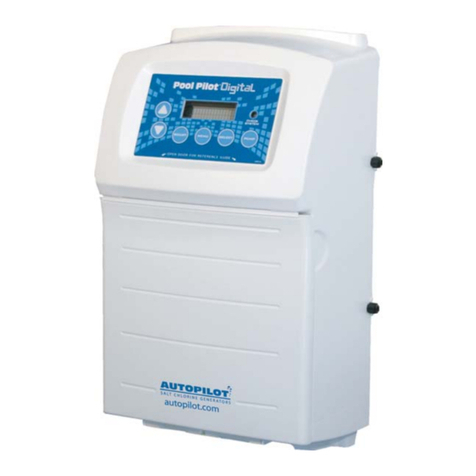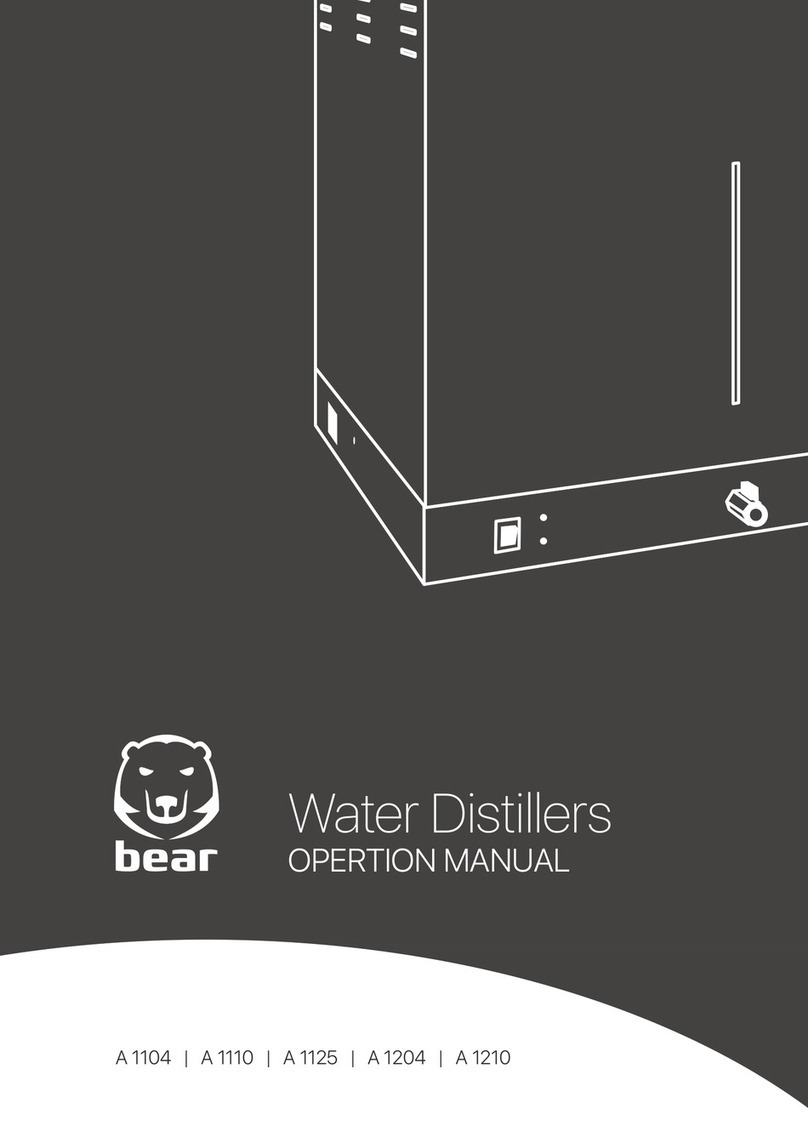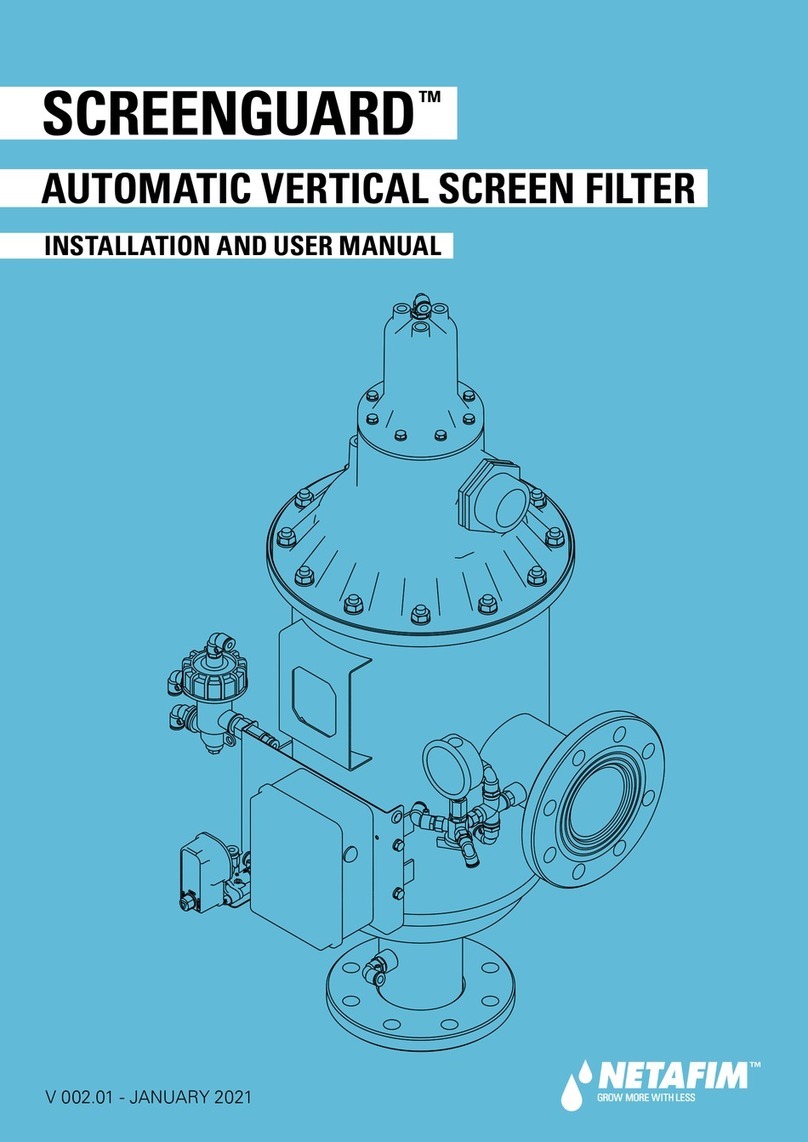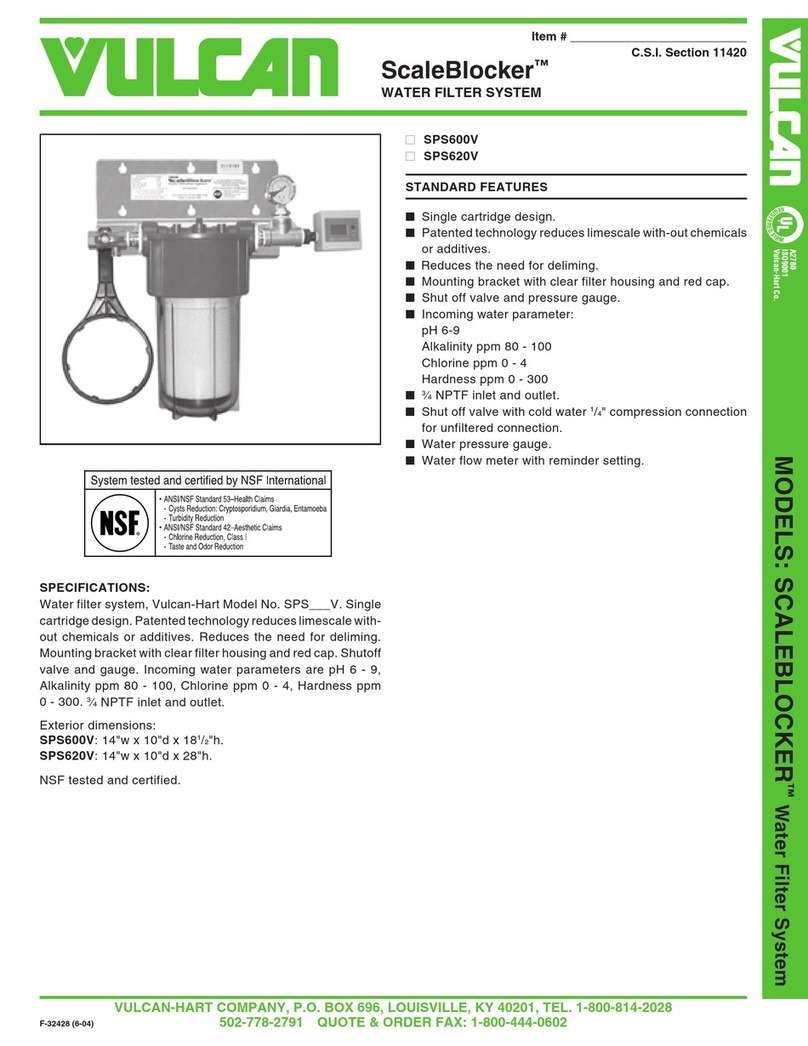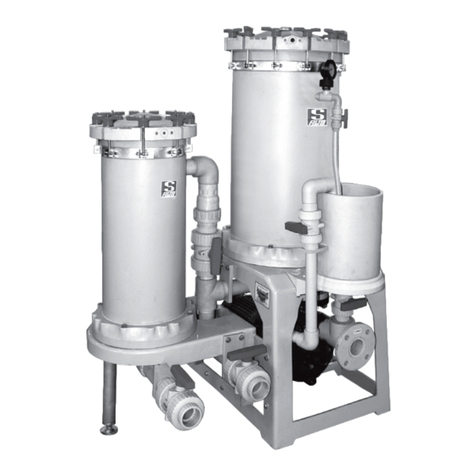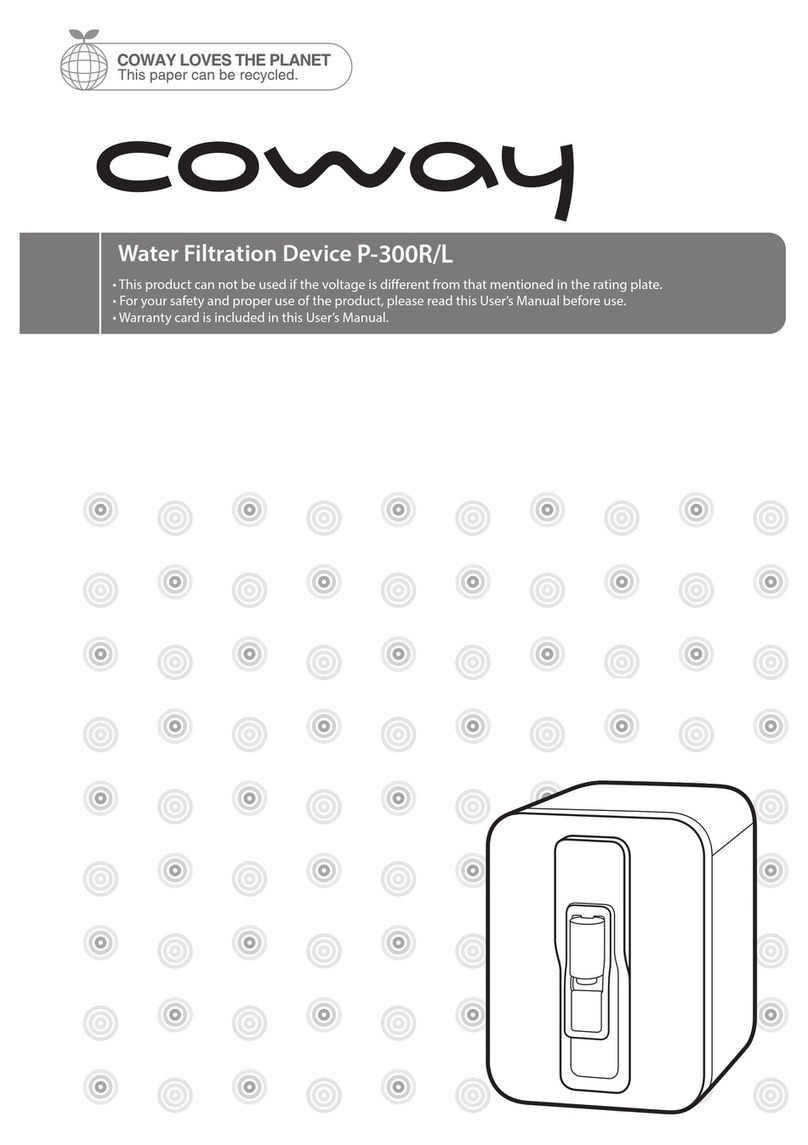Sullair ShopTek ST4 User manual

ST4, ST5, ST7, ST11, ST15
4 – 15 kW (5 – 20 hp)
Three-phase 60 Hz
PART NUMBER:
88292018-236 R00
The information in this manual is current as of its
publication date and applies to compressor models
indicated on this cover with serial number:
37216100224
andallsubsequentserialnumbersuntilnextrevisionof
this manual or release of a replacement manual.
USER MANUAL
Publication date: 03/31/2017
Copyright © 2017 Sullair, LLC. All rights reserved.
WARRANTY NOTICE
Failure to follow the instructions
and procedures in this manual,
or misuse of this equipment, will
void its warranty.
Subject to EAR, ECCN EAR99 and related export control restrictions.
SAFETY WARNING
Users are required to read the
entire User Manual before han-
dling or using the product. Keep
the User Manual in a safe place
for future reference.

Air Care Seminar Training
Sullair Air Care Seminars are courses that provide hands-on instruction for the proper operation, maintenance, and
servicing of Sullair products. Individual seminars on Stationary compressors and compressor electrical systems are
offered at regular intervals throughout the year at Sullair’s training facility located at Michigan City, Indiana.
Instruction includes training on the function and installation of Sullair service parts, troubleshooting common
faults and malfunctions, and actual equipment operation. These seminars are recommended for maintenance,
contractor maintenance, and service personnel.
For detailed course outlines, schedule, and cost information contact:
Sullair Training Department
1-888-SULLAIR or
219-879-5451 (ext. 5623)
www.sullair.com
- Or Write -
Sullair, LLC
3700 E. Michigan Blvd.
Michigan City, IN 46360
Attn: Service Training Department.
Subject to EAR, ECCN EAR99 and related export control restrictions.

Table of Contents
ShopTek™ ST4, ST5, ST7, ST11, ST15 Three-phase 60 Hz User Manual Table of Contents
88292018-236 R00
Subject to EAR, ECCN EAR99 and related export control restrictions. i
Section 1: Safety.......................................................................................................1
1.1 General....................................................................................................... 1
1.2 Personal protective equipment ................................................................... 1
1.3 Pressure release ........................................................................................ 1
1.4 Fire and explosion ...................................................................................... 2
1.5 Moving parts ............................................................................................... 2
1.6 Hot surfaces, sharp edges and sharp corners............................................ 3
1.7 Toxic and irritating substances ................................................................... 3
1.8 Electrical shock........................................................................................... 4
1.9 Lifting.......................................................................................................... 4
1.10 Entrapment................................................................................................. 5
1.11 Implementation of lockout/tagout................................................................ 5
1.12 Safety warnings .......................................................................................... 6
Section 2: Description..............................................................................................9
2.1 Introduction................................................................................................. 9
2.2 Compressor component description........................................................... 9
2.3 Compressor cooling and lubrication system—functional description ....... 14
2.4 Compressor discharge system—functional description............................ 14
2.5 Control system—functional description .................................................... 15
2.6 Air inlet system, functional description ..................................................... 18
2.7 Controller/keypad ..................................................................................... 19
2.8 LCD display .............................................................................................. 19
2.9 LED lights ................................................................................................. 20
Section 3: Specifications.......................................................................................21
3.1 Tables of specifications—ShopTek 5 – 20 hp three-phase ...................... 21
3.2 Lubrication guide ...................................................................................... 22
3.3 Application guide ...................................................................................... 22
3.4 Lubrication change recommendations and fluid filter and separator
maintenance .................................................................................. 22
3.5 Installation drawings (ID), piping & instrumentation diagrams (P&I),
and wiring diagrams (WD) ............................................................. 22

Table of Contents ShopTek™ ST4, ST5, ST7, ST11, ST15 Three-phase 60 Hz User Manual
88292018-236 R00
ii Subject to EAR, ECCN EAR99 and related export control restrictions.
3.6 ID—ST4, ST5, ST7...................................................................................24
3.7 ID—ST11, ST15........................................................................................26
3.8 Piping and instrumentation—ST4, ST5, ST7 ............................................28
3.9 Piping and instrumentation—ST11, ST15.................................................30
Section 4: Installation............................................................................................33
4.1 Compressor mounting—support and location...........................................33
4.1.1 Outdoor installation (sheltered) ........................................................................... 33
4.2 Ventilation and cooling..............................................................................34
4.3 Service air piping ......................................................................................36
4.3.1 Pipe sizing........................................................................................................... 37
4.3.2 Auxiliary receiver tank ......................................................................................... 37
4.3.3 Isolation valves.................................................................................................... 37
4.3.4 Fluid containment................................................................................................ 37
4.4 Belt check .................................................................................................37
4.5 Fluid level check .......................................................................................37
4.6 Electrical preparation ................................................................................37
4.7 Motor rotation direction check...................................................................38
Section 5: Operation..............................................................................................39
5.1 Routine operation......................................................................................39
Section 6: Maintenance .........................................................................................41
6.1 General .....................................................................................................41
6.2 Maintenance after initial 50 hours of operation .........................................41
6.3 Maintenance schedule..............................................................................41
6.3.1 Every 2000 hours of operation or six months (whichever occurs first)................ 41
6.3.2 Every 2000 hours of operation or one year (whichever occurs first)................... 41
6.3.3 Every 4000 hours of operation or one year (whichever occurs first)................... 42
6.3.4 Every one year .................................................................................................... 42
6.3.5 Every two years................................................................................................... 42
6.4 Fluid maintenance.....................................................................................42
6.5 Fluid filter maintenance.............................................................................42
6.5.1 Fluid filter replacement ........................................................................................ 42
6.6 Air filter maintenance ................................................................................43
6.6.1 Air filter element replacement ............................................................................. 43
6.7 Separator maintenance.............................................................................44
6.7.1 Separator element replacement .......................................................................... 45
6.8 Belt maintenance ......................................................................................45
6.8.1 Belt tension measurement with Optikrik tension meter ....................................... 45
6.8.2 Belt tension measurement with frequency meter ................................................ 46
6.8.3 Belt tension adjustment....................................................................................... 46

ShopTek™ ST4, ST5, ST7, ST11, ST15 Three-phase 60 Hz User Manual Table of Contents
88292018-236 R00
Subject to EAR, ECCN EAR99 and related export control restrictions. iii
6.9 Replacement and alignment of belt pulleys.............................................. 50
6.9.1 Instructions for installing a pulley.........................................................................50
6.9.2 Instructions for removing a pulley ........................................................................50
6.10 Hose maintenance.................................................................................... 50
6.11 Tank mount package maintenance .......................................................... 50
6.12 Troubleshooting........................................................................................ 51

Table of Contents ShopTek™ ST4, ST5, ST7, ST11, ST15 Three-phase 60 Hz User Manual
Notes:
88292018-236 R00
iv Subject to EAR, ECCN EAR99 and related export control restrictions.

Section 1
ShopTek™ ST4, ST5, ST7, ST11, ST15 Three-phase 60 Hz User Manual 1: Safety
88292018-236 R00
Subject to EAR, ECCN EAR99 and related export control restrictions. 1
Safety
1.1 General
Sullair and its subsidiaries design and manufacture all of
their products so they can be operated safely. However,
the responsibility for safe operation rests with those who
use and maintain these products. The following safety
precautions are offered as a guide which, if conscien-
tiously followed, will minimize the possibility of accidents
throughout the useful life of this equipment.
The compressor should be operated only by those who
have been trained and delegated to do so, and who have
read and understood this Operator’s Manual. Failure to
follow the instructions, procedures and safety
precautions in this manual may result in accidents and
injuries. NEVER start the compressor unless it is safe to
do so. DO NOT attempt to operate the compressor with a
known unsafe condition. Tag the compressor and render
it inoperative by disconnecting and locking out all power
at source or otherwise disabling its prime mover so
others who may not know of the unsafe condition cannot
attempt to operate it until the condition is corrected.
Install, use and operate the compressor only in full
compliance with all pertinent OSHA regulations and/or
any applicable Federal, State, and Local codes,
standards and regulations. DO NOT modify the
compressor and/or controls in any way except with
written factory approval.
While not specifically applicable to all types of compres-
sors with all types of prime movers, most of the precau-
tionary statements contained herein are applicable to
most compressors and the concepts behind these state-
ments are generally applicable to all compressors.
1.2 Personal protective equipment
A. Prior to installing or operating the compressor, own-
ers, employers and users should become familiar
with, and comply with, all applicable OSHA regula-
tions and/or any applicable Federal, State and Local
codes, standards, and regulations relative to per-
sonal protective equipment, such as eye and face
protective equipment, respiratory protective equip-
ment, equipment intended to protect the extremities,
protective clothing, protective shields and barriers
and electrical protective equipment, as well as noise
exposure administrative and/or engineering controls
and/or personal hearing protective equipment.
1.3 Pressure release
A. Install an appropriate flow-limiting valve between the
service air outlet and the shut-off (throttle) valve,
either at the compressor or at any other point along
the air line, when an air hose exceeding ½″(13 mm)
inside diameter is to be connected to the shut-off
(throttle) valve, to reduce pressure in case of hose
failure, per OSHA Standard 29 CFR 1926.302(b)(7)
and/or any applicable Federal, State and Local
codes, standards and regulations.
B. When the hose is to be used to supply a manifold,
install an additional appropriate flow-limiting valve
between the manifold and each air hose exceeding
½″(13 mm) inside diameter that is to be connected
to the manifold to reduce pressure in case of hose
failure.
C. Provide an appropriate flow-limiting valve at the
beginning of each additional 75 feet (23 m) of hose in
runs of air hose exceeding ½″(13 mm) inside diame-
ter to reduce pressure in case of hose failure.
D. Flow-limiting valves are listed by pipe size and flow-
rated. Select appropriate valves accordingly, in
NOTE
Operator is required to read
entire instruction manual.

1: Safety ShopTek™ ST4, ST5, ST7, ST11, ST15 Three-phase 60 Hz User Manual
88292018-236 R00
2 Subject to EAR, ECCN EAR99 and related export control restrictions.
accordance with their manufacturer's recommenda-
tions.
E. DO NOT use air tools that are rated below the maxi-
mum rating of the compressor. Select air tools, air
hoses, pipes, valves, filters and other fittings accord-
ingly. DO NOT exceed manufacturer’s rated safe
operating pressures for these items.
F. Secure all hose connections by wire, chain or other
suitable retaining device to prevent tools or hose
ends from being accidentally disconnected and
expelled.
G. Open fluid filler cap only when compressor is not run-
ning and is not pressurized. Shut down the compres-
sor and bleed the receiver tank to zero internal
pressure before removing the cap.
H. Vent all internal pressure prior to opening any line, fit-
ting, hose, valve, drain plug, connection or other
component, such as filters and line oilers, and before
attempting to refill optional air line anti-icer systems
with antifreeze compound.
I. Keep personnel out of line with and away from the
discharge opening of hoses or tools or other points of
compressed air discharge.
J. DO NOT use air at pressures higher than 2.1 bar for
cleaning purposes, and then only with effective chip
guarding and personal protective equipment per
OSHA Standard 29 CFR 1910.242(b) and/or any
applicable Federal, State, and Local codes, stan-
dards and regulations.
K. DO NOT engage in horseplay with air hoses as
death or serious injury may result.
1.4 Fire and explosion
A. Clean up spills of lubricant or other combustible sub-
stances immediately, if such spills occur.
B. Shut off the compressor and allow it to cool. Then
keep sparks, flames and other sources of ignition
away and DO NOT permit smoking in the vicinity
when checking or adding lubricant or when refilling
air line anti-icer systems with antifreeze compound.
C. DO NOT permit fluids, including air line anti-icer sys-
tem antifreeze compound or fluid film, to accumulate
on, under or around acoustical material, or on any
external surfaces of the air compressor. Wipe down
using an aqueous industrial cleaner or steam clean
as required. If necessary, remove acoustical mate-
rial, clean all surfaces and then replace acoustical
material. Any acoustical material with a protective
covering that has been torn or punctured should be
replaced immediately to prevent accumulation of liq-
uids or fluid film within the material. DO NOT use
flammable solvents for cleaning purposes.
D. Disconnect and lock out all power at source prior to
attempting any repairs or cleaning of the compressor
or of the inside of the enclosure, if any.
E. Keep electrical wiring, including all terminals and
pressure connectors in good condition. Replace any
wiring that has cracked, cut, abraded or otherwise
degraded insulation, or terminals that are worn, dis-
colored or corroded. Keep all terminals and pressure
connectors clean and tight.
F. Keep grounded and/or conductive objects such as
tools away from exposed live electrical parts such as
terminals to avoid arcing which might serve as a
source of ignition.
G. Remove any acoustical material or other material
that may be damaged by heat or that may support
combustion and is in close proximity, prior to attempt-
ing weld repairs.
H. Keep suitable fully charged Class BC or ABC fire
extinguisher or extinguishers nearby when servicing
and operating the compressor.
I. Keep oily rags, trash, leaves, litter or other combusti-
bles out of and away from the compressor.
J. DO NOT operate the compressor without proper flow
of cooling air or water or with inadequate flow of lubri-
cant or with degraded lubricant.
K. DO NOT attempt to operate the compressor in any
classification of hazardous environment unless the
compressor has been specially designed and manu-
factured for that duty.
1.5 Moving parts
A. Keep hands, arms and other parts of the body and
clothing away from couplings, belts, pulleys, fans and
other moving parts.
B. DO NOT attempt to operate the compressor with the
fan, coupling or other guards removed.
C. Wear snug-fitting clothing and confine long hair when
working around this compressor, especially when
exposed to hot or moving parts.
D. Keep access doors, if any, closed except when mak-
ing repairs or adjustments.

ShopTek™ ST4, ST5, ST7, ST11, ST15 Three-phase 60 Hz User Manual 1: Safety
88292018-236 R00
Subject to EAR, ECCN EAR99 and related export control restrictions. 3
E. Make sure all personnel are out of and/or clear of the
compressor prior to attempting to start or operate it.
F. Disconnect and lock out all power at source and ver-
ify at the compressor that all circuits are de-energized
to minimize the possibility of accidental start-up, or
operation, prior to attempting repairs or adjustments.
This is especially important when compressors are
remotely controlled.
G. Keep hands, feet, floors, controls and walking sur-
faces clean and free of fluid, water or other liquids to
minimize the possibility of slips and falls.
1.6 Hot surfaces, sharp edges and
sharp corners
A. Avoid bodily contact with hot fluid, hot coolant, hot
surfaces and sharp edges and corners.
B. Keep all parts of the body away from all points of air
discharge.
C. Wear personal protective equipment including gloves
and head covering when working in, on or around the
compressor.
D. Keep a first aid kit handy. Seek medical assistance
promptly in case of injury. DO NOT ignore small cuts
and burns as they may lead to infection
1.7 Toxic and irritating substances
A. DO NOT use air from this compressor for respiration
(breathing) except in full compliance with OSHA
Standards 29 CFR 1910 and/or any applicable Fed-
eral, State or Local codes or regulations.
B. DO NOT use air line anti-icer systems in air lines
supplying respirators or other breathing air utilization
equipment and DO NOT discharge air from these
systems into unventilated or other confined areas.
C. Operate the compressor only in open or adequately
ventilated areas.
D. Locate the compressor or provide a remote inlet so
that it is not likely to ingest exhaust fumes or other
toxic, noxious or corrosive fumes or substances.
E. Coolants and lubricants used in this compressor are
typical of the industry. Care should be taken to avoid
accidental ingestion and/or skin contact. In the event
of ingestion, seek medical treatment promptly. Wash
with soap and water in the event of skin contact.
Consult Material Safety Data Sheet for information
pertaining to fluid of fill.
F. Wear goggles or a full face shield when adding anti-
freeze compound to air line anti-icer systems.
G. If air line anti-icer system antifreeze compound
enters the eyes or if fumes irritate the eyes, they
should be washed with large quantities of clean
water for fifteen minutes. A physician, preferably an
eye specialist, should be contacted immediately.
H. DO NOT store air line anti-icer system antifreeze
compound in confined areas.
I. The antifreeze compound used in air line antifreeze
systems contains methanol and is toxic, harmful or
fatal if swallowed. Avoid contact with the skin or eyes
and avoid breathing the fumes. If swallowed, induce
vomiting by administering a tablespoon of salt, in
each glass of clean, warm water until vomit is clear,
then administer two teaspoons of baking soda in a
glass of clean water. Have patient lay down and
DANGER
Death or serious injury can result from inhaling
compressed air without using proper safety
equipment. See OSHA standards and/or any
applicable Federal, State, and Local codes, stan-
dards and regulations on safety equipment.

1: Safety ShopTek™ ST4, ST5, ST7, ST11, ST15 Three-phase 60 Hz User Manual
88292018-236 R00
4 Subject to EAR, ECCN EAR99 and related export control restrictions.
cover eyes to exclude light. Call a physician immedi-
ately.
1.8 Electrical shock
A. This compressor should be installed and maintained
in full compliance with all applicable Federal, State
and Local codes, standards and regulations, includ-
ing those of the National Electrical Code, and also
including those relative to equipment grounding con-
ductors, and only by personnel that are trained, qual-
ified and delegated to do so.
B. Keep all parts of the body and any hand-held tools or
other conductive objects away from exposed live
parts of electrical system. Maintain dry footing, stand
on insulating surfaces and DO NOT contact any
other portion of the compressor when making adjust-
ments or repairs to exposed live parts of the electrical
system. Make all such adjustments or repairs with
one hand only, so as to minimize the possibility of
creating a current path through the heart.
C. Attempt repairs in clean, dry and well lighted and
ventilated areas only.
D. DO NOT leave the compressor unattended with open
electrical enclosures. If necessary to do so, then discon-
nect, lock out and tag all power at source so others will
not inadvertently restore power.
E. Disconnect, lock out, and tag all power at source
prior to attempting repairs or adjustments to rotating
machinery and prior to handling any ungrounded
conductors.
1.9 Lifting
A. If the compressor is provided with a lifting bail, then
lift by the bail provided. If no bail is provided, then lift
by sling. Compressors to be air-lifted by helicopter
must not be supported by the lifting bail but by slings
instead. In any event, lift and/or handle only in full
compliance with OSHA standards 29 CFR 1910 sub-
part N and/or any applicable Federal, State, and
Local codes, standards and regulations.
B. Inspect points of attachment for cracked welds and
for cracked, bent, corroded or otherwise degraded
members and for loose bolts or nuts prior to lifting.
C. Make sure entire lifting, rigging and supporting struc-
ture has been inspected, is in good condition and has
a rated capacity of at least the weight of the com-
pressor. If you are unsure of the weight, then weigh
compressor before lifting.
D. Make sure lifting hook has a functional safety latch or
equivalent, and is fully engaged and latched on the
bail or slings.
E. Use guide ropes or equivalent to prevent twisting or
swinging of the compressor once it has been lifted
clear of the ground.
F. DO NOT attempt to lift in high winds.
G. Keep all personnel out from under and away from the
compressor whenever it is suspended.
H. Lift compressor no higher than necessary.
I. Keep lift operator in constant attendance whenever
compressor is suspended.
DANGER
All field equipment must be tested for electro-
static fields prior to servicing or making contact
with the machine using the following or equiva-
lent test equipment:
• 90 – 600 VAC: Volt detector such as
Fluke Model 1AC-A
• 600 – 7000 VAC: Voltage detector such
as Fluke Networks Model C9970
It is the responsibility of each organization to
provide/arrange training for all their associates
expected to test for electrostatic fields.

ShopTek™ ST4, ST5, ST7, ST11, ST15 Three-phase 60 Hz User Manual 1: Safety
88292018-236 R00
Subject to EAR, ECCN EAR99 and related export control restrictions. 5
J. Set compressor down only on a level surface capa-
ble of safely supporting at least its weight and its
loading unit.
K. When moving the compressor by forklift truck, utilize
fork pockets if provided. Otherwise, utilize pallet if
provided. If neither fork pockets or pallet are pro-
vided, then make sure compressor is secure and well
balanced on forks before attempting to raise or trans-
port it any significant distance.
L. Make sure forklift truck forks are fully engaged and
tipped back prior to lifting or transporting the com-
pressor.
M. Forklift no higher than necessary to clear obstacles
at floor level and transport and corner at minimum
practical speeds.
N. Make sure pallet-mounted compressors are firmly
bolted or otherwise secured to the pallet prior to
attempting to forklift or transport them. NEVER
attempt to forklift a compressor that is not secured to
its pallet, as uneven floors or sudden stops may
cause the compressor to tumble off, possibly causing
serious injury or property damage in the process.
1.10 Entrapment
A. If the compressor enclosure, if any, is large enough
to hold a man and if it is necessary to enter it to per-
form service adjustments, inform other personnel
before doing so, or else secure and tag the access
door in the open position to avoid the possibility of
others closing and possibly latching the door with
personnel inside.
B. Make sure all personnel are out of compressor
before closing and latching enclosure doors.
1.11 Implementation of lockout/tagout
The energy control procedure defines actions necessary
to lockout a power source of any machine to be repaired,
serviced or set-up, where unexpected motion, or an
electrical or other energy source, would cause personal
injury or equipment damage. The power source on any
machine shall be locked out by each employee doing the
work except when motion is necessary during setup,
adjustment or trouble-shooting.
A. The established procedures for the application of
energy control shall cover the following elements and
actions and shall be initiated only by Authorized Per-
sons and done in the following sequence:
1. Review the equipment or machine to be
locked and tagged out.
2. Alert operator and supervisor of which
machine is to be worked on, and that power
and utilities will be turned off.
3. Check to make certain no one is operating
the machine before turning off the power.
4. Turn off the equipment using normal shut-
down procedure.
5. Disconnect the energy sources:
a. Air and hydraulic lines should be bled,
drained and cleaned out. There should
be no pressure in these lines or in the
reservoir tanks. Lockout or tag lines or
valves.
b. Any mechanism under tension or pres-
sure, such as springs, should be
released and locked out or tagged.
c. Block any load or machine part prior to
working under it.
d. Electrical circuits should be checked with
calibrated electrical testing equipment
and stored energy and electrical capaci-
tors should be safely discharged.
6. Lockout and/or Tagout each energy source
using the proper energy isolating devices
and tags. Place lockout hasp and padlock or
tag at the point of power disconnect where
lockout is required by each person perform-
ing work. Each person shall be provided with
their own padlock and have possession of
the only key. If more than one person is
working on a machine each person shall affix
personal lock and tag using a multi-lock
device.
7. Tagout devices shall be used only when
power sources are not capable of being
locked out by use of padlocks and lockout
hasp devices. The name of the person affix-
ing tag to power source must be on tag along
with date tag was placed on power source.
8. Release stored energy and bring the equip-
ment to a “zero mechanical state”.
9. Verify Isolation: Before work is started, test
equipment to ensure power is disconnected.
B. General Security
1. The lock shall be removed by the “Autho-
rized” person who put the lock on the
energy-isolating device. No one other than
the person/persons placing padlocks and

1: Safety ShopTek™ ST4, ST5, ST7, ST11, ST15 Three-phase 60 Hz User Manual
88292018-236 R00
6 Subject to EAR, ECCN EAR99 and related export control restrictions.
lockout hasps on power shall remove pad-
lock and lockout hasps and restore power.
However, when the authorized person who
applied the lock is unavailable to remove it
his/her Supervisor may remove padlock/pad-
locks and lockout hasps and restore power
only if it is first:
a. verified that no person will be exposed to
danger.
b. verified that the “Authorized” person who
applied the device is not in the facility.
c. noted that all reasonable efforts to con-
tact the “Authorized” person have been
made to inform him or her that the lock-
out or tagout device has been removed.
d. ensured that the “Authorized” person is
notified of lock removal before returning
to work.
2. Tagout System—Tags are warning devices
affixed at points of power disconnect and are
not to be removed by anyone other that the
person placing tag on power lockout. Tags
shall never be by-passed, ignored, or other-
wise defeated.
1.12 Safety warnings
The following special instructions apply to VSD packages
provided with electronic adjustable speed motor drives.
These cautions that apply to VSD operation.
WARNING
Ground the unit following the instructions in this
manual. Ungrounded units may cause electric
shock and/or fire. The variable speed drive has a
large capacitive leakage current during opera-
tion, which can cause enclosure parts to be
above ground potential. Proper grounding, as
described in this manual, is required. Failure to
observe this precaution could result in death or
severe injury.
WARNING
Before applying power to the variable speed
drive, make sure that the front and cable covers
are closed and fastened to prevent exposure to
potential electrical fault conditions. Failure to
observe this precaution could result in death or
severe injury.
WARNING
Refer all drive service to trained technicians.
This equipment should be installed, adjusted,
and serviced by qualified electrical maintenance
personnel familiar with the construction and
operation of this type of equipment and the haz-
ards involved and in accordance with published
service manuals. Failure to observe this precau-
tion could result in death or severe injury.
WARNING
Line terminals (L1, L2, L3), motor terminals (U,
V, W) and the DC link/brake resistor terminals (-/
+) are live when the drive is connected to power,
even if the motor is not running. Contact with
this voltage is extremely dangerous and may
cause death or severe injury.

ShopTek™ ST4, ST5, ST7, ST11, ST15 Three-phase 60 Hz User Manual 1: Safety
88292018-236 R00
Subject to EAR, ECCN EAR99 and related export control restrictions. 7
WARNING
Before opening the variable speed drive covers:
• Disconnect all power to the variable
speed drive.
• Wait a minimum of 5 (five) minutes
after all the lights on the keypad are
off. This allows time for the DC bus
capacitors to discharge.
• A hazard voltage may still remain in
the DC bus capacitors even if the
power has been turned off. Confirm
that the capacitors have fully dis-
charged by measuring their voltage
using a multimeter set to measure DC
voltage. Failure to follow the above
precautions may cause death or
severe injury.
CAUTION
Do not perform any megger or voltage withstand
tests on any part of the variable speed drive or
its components. Improper testing may result in
damage. Prior to any tests or measurements of
the motor or the motor cable, disconnect the
motor cable at the variable speed drive output
terminals (U, V, W) to avoid damaging the vari-
able speed drive during motor or cable testing.
CAUTION
Do not touch any components on the circuit
boards. Static voltage discharge may damage
the components.
CAUTION
Install the variable speed drive in a well venti-
lated room that is not subject to temperature
extremes, high humidity, or condensation, and
avoid locations that are directly exposed to sun-
light, or have high concentrations of dust, corro-
sive gas, explosive gas, inflammable gas,
grinding fluid mist, etc. Improper installation may
result in a fire hazard.
CAUTION
Make sure that no power correction capacitors
are connected to the variable speed drive output
or the motor terminals to prevent variable speed
drive malfunction and potential damage.
CAUTION
Make sure that the variable speed drive output
terminals (U, V, W) are not connected to the util-
ity line power as severe damage to the VSD may
occur.
NOTE
Interior electrical wiring is performed at the fac-
tory. Required customer wiring is minimal, but
should be done by a qualified electrician in com-
pliance with OSHA, National Electrical Code,
and/or any other applicable State, Federal, and
local electrical codes concerning isolation
switches, fused disconnects, etc. Sullair pro-
vides a wiring diagram for use by the installer.
NOTE
Customer must provide electrical supply power
disconnect within sight of machine.

1: Safety ShopTek™ ST4, ST5, ST7, ST11, ST15 Three-phase 60 Hz User Manual
Notes:
88292018-236 R00
8 Subject to EAR, ECCN EAR99 and related export control restrictions.

Section 2
ShopTek™ ST4, ST5, ST7, ST11, ST15 Three-phase 60 Hz User Manual 2: Description
88292018-236 R00
Subject to EAR, ECCN EAR99 and related export control restrictions. 9
Description
2.1 Introduction
The design of the Sullair ShopTek line of compressor
units is a single stage, positive displacement, flooded
rotary screw. A complete package includes the:
• Compressor unit
•Electric motor
•Starter
• Compressor inlet and discharge systems
• Compressor lubrication and cooling system
• Controller
• Aftercooler (ST11 and ST15 only)
• Heavy gauge steel mounting frame
New compressors are shipped from the factory fully
charged with Sullube®lubrication fluid. Section 3.2 and
Section 3.3 describe lubrication requirements and recom-
mendations for each compressor package.
External piping, connectors, and the enclosure should be
inspected and maintained in accordance with the proce-
dures and recommendations in this manual.
2.2 Compressor component
description
The ShopTek compressor (Figure 2-1 and Figure 2-2)
uses a fan to draw outside air into the enclosure, cooling
the motors, the combined radiator fluid cooler, and air
aftercooler. This hot air is then vented out of the top of
the enclosure.
Fluid is injected into the compressor, and mixes directly
with the air as the rotors turn which compresses the air.
The fluid flow has three basic functions:
• As a coolant, it controls the air temperature rise
normally associated with the heat of compres-
sion.
• Seals the clearance paths between the rotors
and the stator, and also between the two rotors.
• Provides a lubricating film between the rotors
allowing one rotor to directly drive the other,
which is an idler, and also lubricates the bearings.
After the air/fluid mixture is discharged from the compres-
sor unit, the fluid is separated from the air. At this time,
the air flows through an aftercooler and separator, and
then to the service line while the fluid is cooled and fil-
tered in preparation for reinjection.
CAUTION
Use only one type of a recommended compres-
sor lubricant. Adding a different one, or mixing
lubricants can cause damage and/or malfunc-
tions, and will void the compressor’s warranty.
NOTE
The compressor air end requires no internal
inspections or maintenance actions. Opening
the compressor air end’s housing may void its
warranty. (This does not apply to the shaft seal
or inlet valve which are replaceable.)

2: Description ShopTek™ ST4, ST5, ST7, ST11, ST15 Three-phase 60 Hz User Manual
88292018-236 R00
10 Subject to EAR, ECCN EAR99 and related export control restrictions.
Figure 2-1: Main components—ST4, ST5, ST7
1. Fluid filter 7. E-stop button
2. Fluid cooler 8. Controller
3. Air inlet filter 9. Main motor
4. Separator tube 10. Compressor unit
5. Fluid fill sight glass 11. Cooler fan motor
6. Fluid fill

ShopTek™ ST4, ST5, ST7, ST11, ST15 Three-phase 60 Hz User Manual 2: Description
88292018-236 R00
Subject to EAR, ECCN EAR99 and related export control restrictions. 11
Figure 2-2: Main components—ST11, ST15
1. Fluid filter 7. E-stop button
2. Aftercooler/fluid cooler 8. Controller
3. Air inlet filter 9. Main motor
4. Separator tube 10. Compressor unit
5. Fluid fill sight glass 11. Cooler fan motor
6. Fluid fill

2: Description ShopTek™ ST4, ST5, ST7, ST11, ST15 Three-phase 60 Hz User Manual
88292018-236 R00
12 Subject to EAR, ECCN EAR99 and related export control restrictions.
Figure 2-3: Cooling/lubrication and discharge system—ST4, ST5, ST7
1. Separator tube 5. Separator element
2. Cooler 6. Air
3. Fluid filter 7. Air/fluid mix
4. Compressor unit 8. Fluid

ShopTek™ ST4, ST5, ST7, ST11, ST15 Three-phase 60 Hz User Manual 2: Description
88292018-236 R00
Subject to EAR, ECCN EAR99 and related export control restrictions. 13
Figure 2-4: Cooling/lubrication and discharge system—ST11, ST15
1. Separator tube 5. Separator element
2. Cooler 6. Air
3. Fluid filter 7. Air/fluid mix
4. Compressor unit 8. Fluid

2: Description ShopTek™ ST4, ST5, ST7, ST11, ST15 Three-phase 60 Hz User Manual
88292018-236 R00
14 Subject to EAR, ECCN EAR99 and related export control restrictions.
2.3 Compressor cooling and
lubrication system—functional
description
Refer to Figure 2-3 and Figure 2-4. The cooling and lubri-
cation system consists of a fan, fan motor, aftercooler
(ST11/ST15 only) / fluid cooler, full flow fluid filter, thermal
valve, interconnecting hoses and separator tube.
The pressure in the separator tube starts the fluid flow by
forcing the fluid from the high pressure area of the tube to
an area of lower pressure in the compressor unit. Fluid
flows from the bottom of the separator/tube to the thermal
valve that is fully open when the fluid temperature is
below 185°F (85°C) [195°F (91°C) for pressures rated
above 150 psig]. The fluid passes through the thermal
valve, the fluid filter, and directly to the compressor where
it lubricates, cools and seals the rotors, and the compres-
sion chamber.
As the discharge temperature rises above 185°F (85°C)
[195°F (91°C) for pressures rated above 150 psig], due
to the heat of compression, the thermal valve begins to
adjust and a portion of the fluid then flows through the
cooler. From the cooler the fluid flows to the fluid filter
and on to the compressor. A portion of the fluid flow to
the compressor is routed to the anti-friction bearings
which support the compressor rotors.
The fluid filter must be replaced. Refer to Section 3.4:
Lubrication change recommendations and fluid filter and
separator maintenance on page 22.
2.4 Compressor discharge system—
functional description
Refer to Figure 2-3 and Figure 2-4. The compressor dis-
charges the compressed air/fluid mixture into the separa-
tor/tube. The separator/tube has three basic functions:
• It acts as a primary fluid separator.
•Serves as the compressor fluid sump.
• Houses the final fluid separator.
The compressed air/fluid mixture enters the separator/
tube and flows through an internal baffle system that
changes the flow’s direction and velocity, which causes
most of the fluid to fall to the bottom of the separator
tube. A small amount of fluid remaining in the com-
pressed air collects on the surface of the separator ele-
ment as the air flows through the separator.
A return line (or scavenge tube) leads from the dry side of
the separator tube to the medium pressure region. Scav-
enged fluid is returned by a pressure differential between
the separator tube and compressor.
The separator system reduces the fluid carry-over to less
than 2 ppm at nominal rated pressures.
The controller will shut down the compressor if the dis-
charge temperature reaches 235°F (113°C).
A minimum pressure/check valve located downstream
from the separator maintains the separator tube pressure
at 50 psig (3.4 bar) during load conditions. This pressure
level is necessary for proper air/fluid separation and suffi-
cient fluid circulation.
A terminal check valve is a sub-component of the mini-
mum pressure/check valve that prevents compressed air
in the service line from back-flowing into the separator
tube on shutdown or when the compressor is operating in
an unload condition. Also, a pressure relief valve on the
compressor’s wet side opens if the separator tube pres-
sure exceeds its rating.
Add fluid to the separator tube through the capped fluid
fill port. There is also a sight glass that enables the user
to check the separator tube fluid level. See Section 4.5:
Fluid level check on page 37.
WARNING
Stop the compressor and relieve all internal
pressure before removing caps, plugs, and/or
other components when the compressor is run-
ning or pressurized.
This manual suits for next models
4
Table of contents
Other Sullair Water Filtration System manuals
Popular Water Filtration System manuals by other brands
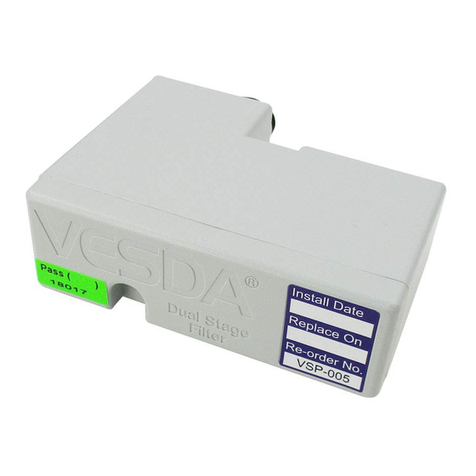
Xtralis
Xtralis VESDA VSP-005 Cartridge Replacement Instructions
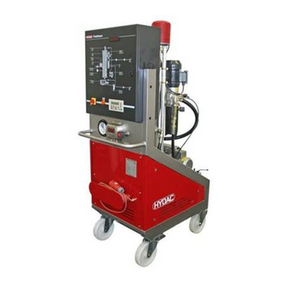
Hydac
Hydac FluidAqua Mobil Series Operating and maintenance instructions

Eureka Forbes
Eureka Forbes Aquaguard Verve user guide
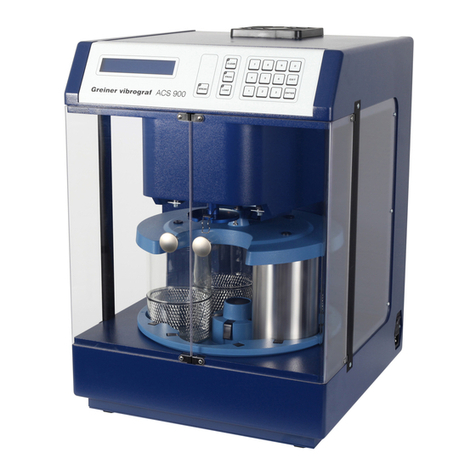
Greiner Vibrograf
Greiner Vibrograf ACS 900 Manual and instruction
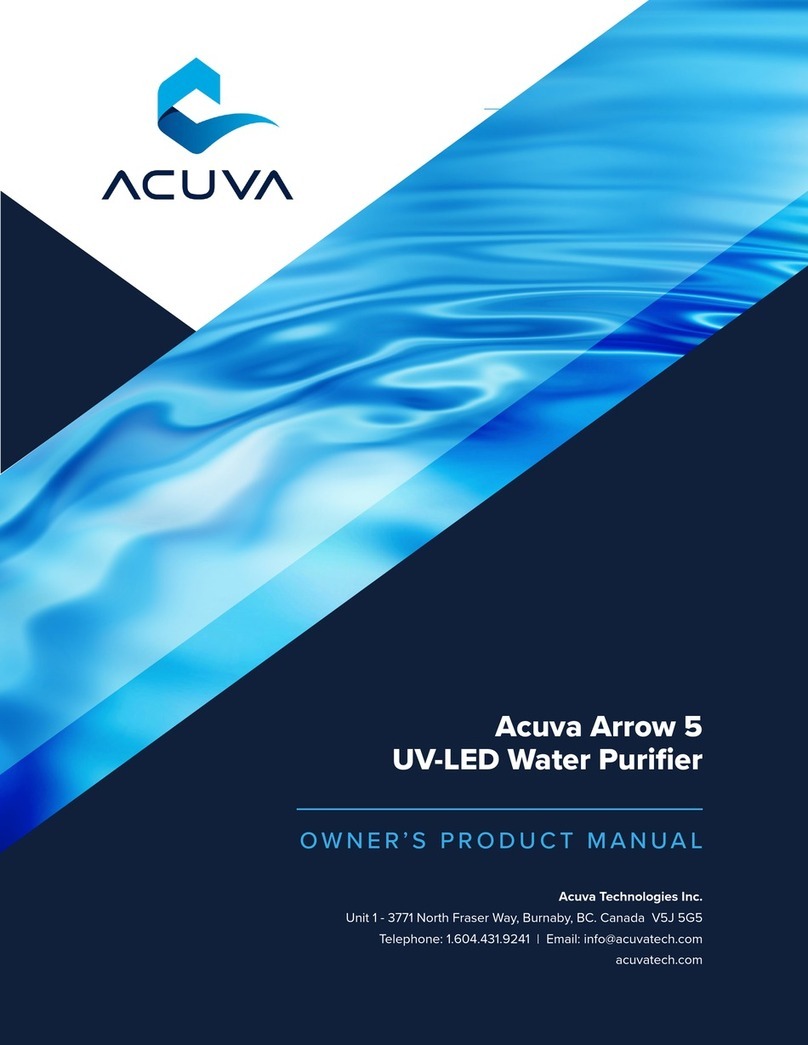
Acuva
Acuva Arrow 5 Owner's Product Manual
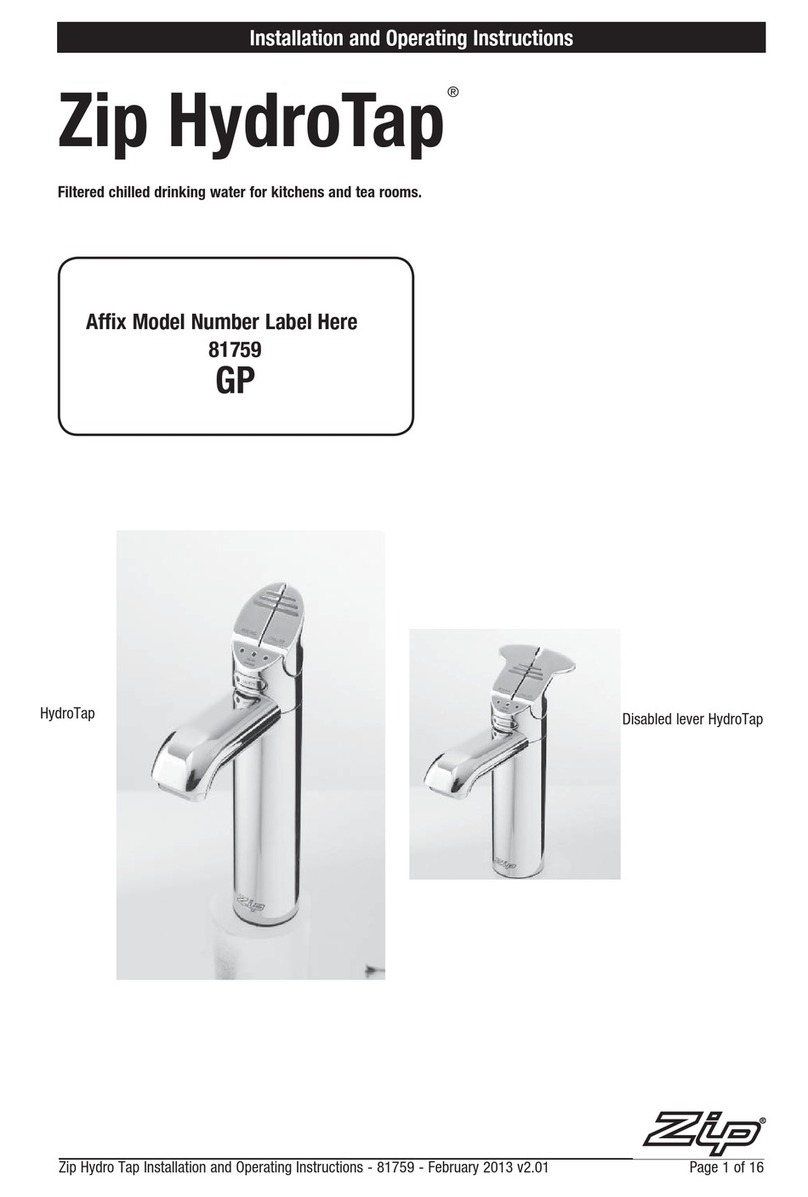
Zip
Zip HydroTap series Installation & operating instruction

